Updated June 15, 2024,
with the removal of the hyrax, Procavia, from the lineage of elephants and sea cows, replaced with sabertoothed carnivorans in yet another phylogenetically miniaturized taxon, Amphicynodon and Ocepeia.
Several taxa have traditionally lined themselves up phylogenetically
as elephant ancestors (Figs 1, 2). Below are the skulls of a pre-sea cow, Moeritherium and a hyrax, Procavia (Fig 1) and their skeletons (Fig 2). Phosphatitherium is also in this clade, usually nesting between these two.
According to Wikipedia – Moeritherium
“Moeritherium (“the beast from Lake Moeris“) is an extinct genus of primitive proboscideans. These prehistoric mammals are related to the elephant and, more distantly, sea cows and hyraxes.”

Figure 1. Procavia, the rock hyrax, to scale with extinct Moeritherium, Numidothirium and Phosphatitherium. Note the large incisors as in elephant tusks.
Large incisors in hyraxes and manatees
are traditionally associated with elephant incisors. However, in the large reptile tree (LRT, 2319 taxa). such incisors on hyraxas are now convergent traits with those of elephants + manatees. There are other taxa that have large incisors and are (currently) ancestral to elephants.

Figure 2. Skeletons of stylinodons (Psittacotherium), Moeritherium, Prorastomus and Dusisiren demonstrating the evolution of sea cows from these taxa in the LRT.
Today,
one LRT taxon is revised and rescored with better data revealing overlooked elephantine traits=, the traditional taeniodont/ stylodont Psittacotherium (Figs 3–7). This clade predates the last few years of the Mesozoic with Schowalteria.
Another traditional elephant ancestor is today added to the LRT,
Numidotherium (Fig 1) nesting most closely basal to elephants. Prior drawings don’t locate the nose. The yellow premaxilla surrounds it here.
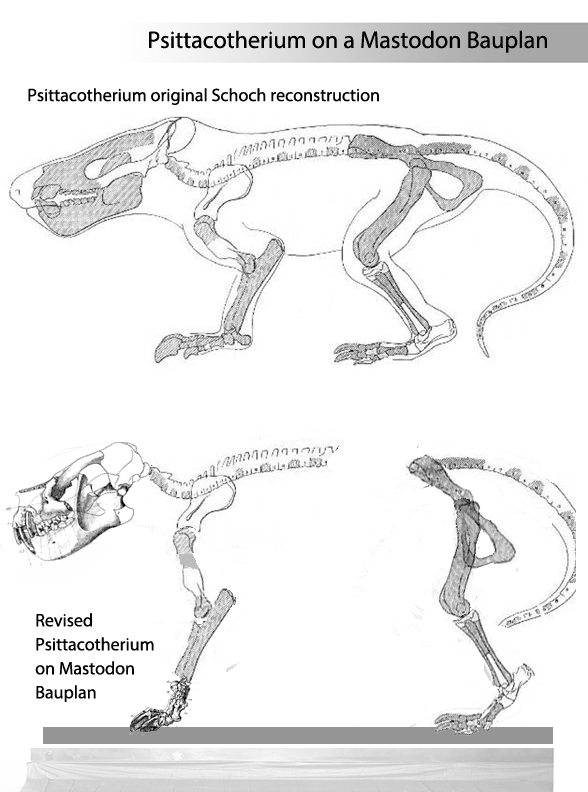
Figure 3. Psittacotherium skeleton compared to Mastodon and revised to fit the Mastodon Bauplan.
On the topic of elephants,
Begum 2021 wrote an online article entitled, “The rise and fall of elephant ancestors.” So this topic has been an ongoing one. At the time, Begum was writing about Eritherium (Fig 1) from the Paleocene. Back then what little was known of Eritherium was a good match for the wombat marsupial, Notostylops in the LRT.
That hasn’t changed since then.
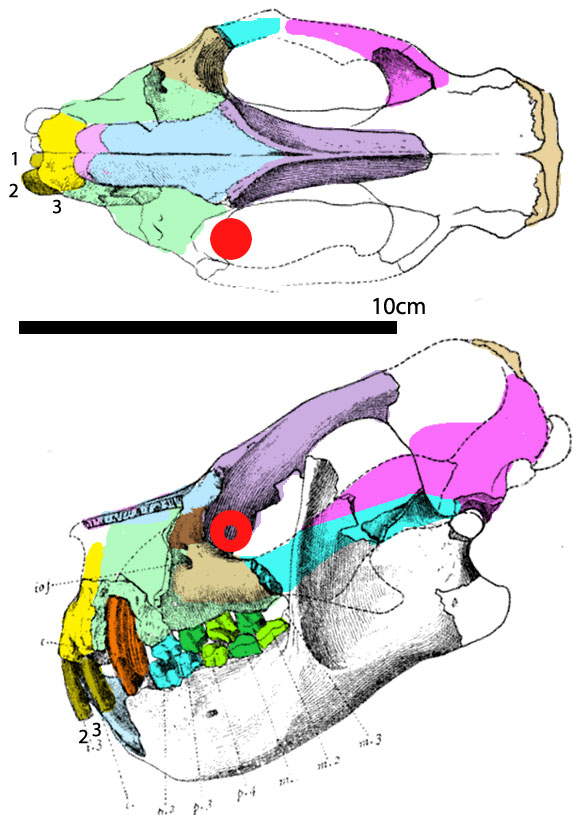
Figure 4. Psittacotherium skulls. Colors added here. Several differences here. I scored traits based on the photo material. Note the long incisors. This taxon currently nests basal to manatees + elephants.
Psittacotherium
has never entered any discussions of elephant ancestry, until now. This represents yet another case of taxon exclusion. Add taxa to resolve enigmas.
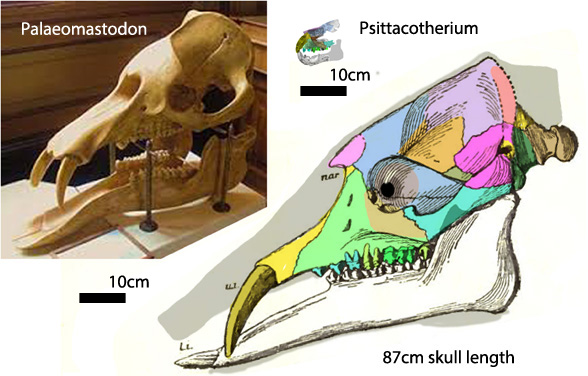
Figure 5. Paleocene Psittacotherium and Oligocene Paleomastodon skulls to scale. Tens of millions of years separate these two.
The manus and pes of Psittacotherium
(Figs 6, 7) could have evolved into those of graviportal Elephas with the reduction of unguals and development of a foot pad, perhaps already present in Psittacotherium, with increasing size over the course of the intervening 60 million years. Prior workers never considered this possibility, so when reconstructing the missing digits in Psittacotherium chose to illustrate larger medial and lateral digits.
Here an elephant Bauplan (Figs 6, 7) suggests smaller medial and lateral fingers and toes were likely also present in Psittacotherium.
Combs 1983 reported,
“Among stylinodontines, the pes is best known in Psittacotherium (Matthew, 1937) and an “undetermined stylinodont” (Gazin, 1952). In the latter, five digits were present and well developed; the arrangement of the digits was somewhat arcuate, such that digits I and V approached one another at the volar surface of the foot (fig. 11A). Weight was borne primarily on the distal surface of the metatarsals and their sesamoids”.
This also describes the morphology in elephants.
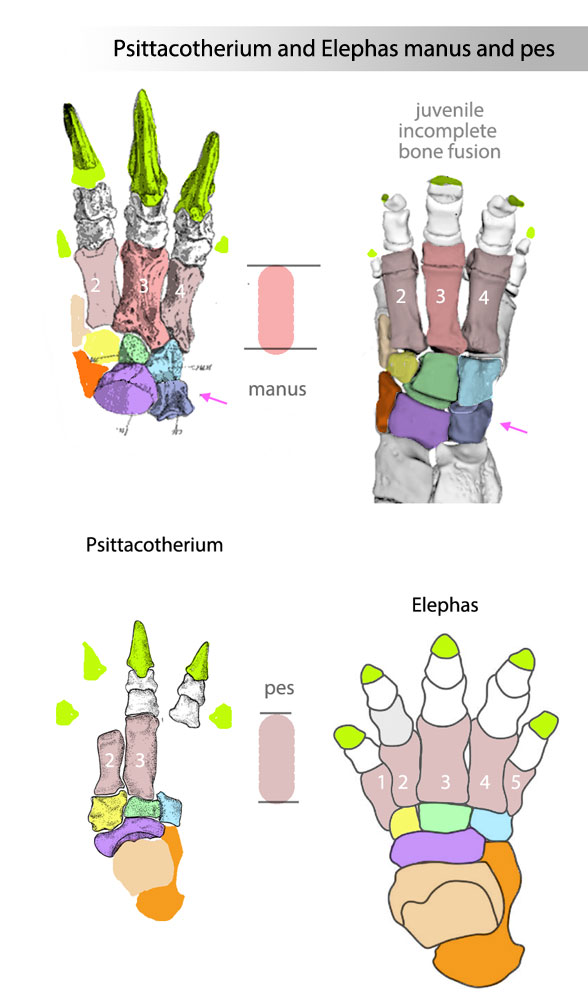
Figure 6. Manus and pes for Psittacotherium and Elephas. Colors added here. This represents 60 million years of evolution.
Other clawed herbivores
(eg Homalodotherium) evolved hooves in artiodactyls according to Combs 1983 and confirmed in the LRT.
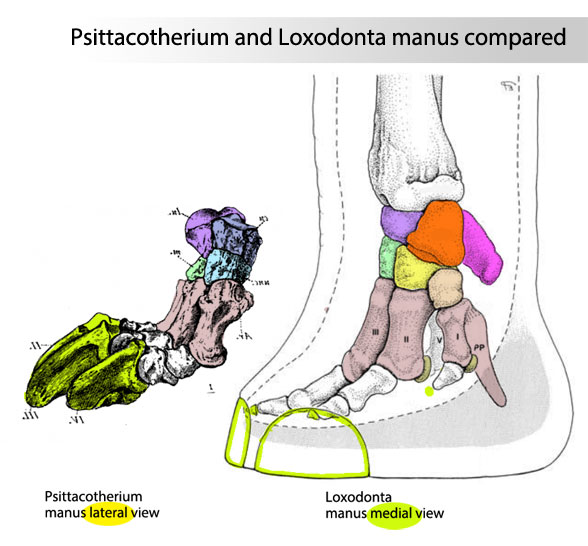
Figure 7. Psittacotherim and Loxodonta (African elephant) manus to scale. Colors added here. PP = prepollux, an extended cartilaginous sesamoid that ossifies and is buried in the fat pad. Digit 1 remains unknown in Psittacotherium, so whether it had a spur developing off mt1 is unknown.
Hutchinson JR et al 2011 described
the ‘sixth toes’ of elephants (= cartilaginous prepollux, prehallux, Fig 7). They followed tradition when they reported, “The vexing issue of the homology of elephant predigits remains unresolved, complicated by the specialization of paenungulate outgroups (such as Sirenia and Hyracoidea).”
Psittacotherium fossils (Fig 7) do not preserve a prepollux nor a prehallux.
“The cartilaginous predigits are slowly replaced by bone during late ontogeny, but that this bone is unusual in its development. Ossification typically begins years after other sesamoids have become well mineralized, and it occurs in a large cartilage structure surrounded by a fat pad rather than by tendon or ligament.”
“We conclude that the predigits have served to stiffen the expanded fat pad and maintain a plantigrade-like foot function, transferring loads from the substrate to the carpus/tarsus,
since early in elephantiform evolution.”
Nesting stylinodontids closer to elephants
appears to be a novel hypothesis of interrelationships. If not, please provide a citation so I can promote it here.
References
Begum T 2021. “The rise and fall of elephant ancestors.” Science News. nmh.ac.uk
Combs M 1983. Large mammalian clawed herbivores: A comparative study. Transactions of the American Philosophical Society 73(7)96pp. online
Gazin CL 1952. The lower Eocene Knight Formation of western Wyoming and its mammalian faunas. Smithsonian Misc. Collections 117, 18: 1-82.
Hutchinson JR et al 2011. From flat foot to fat foot: Structure, ontogeny, function, and evolution of elephant “sixth toes”. Science 334:1699. DOI: 10.1126/science.1211437
Saarinen J and Lister AM 2023. Fluctuating climate and dietary innovation drove ratcheted evolution of proboscidean dental traits. Nat Ecol Evol 7, 1490–1502. https://doi.org/10.1038/s41559-023-02151-4
Siegal-Willott, J, Isaza R, Johnson R and Blaik, M 2008. Distal limb radiography, ossification, and growth plate closure in the juvenile Asian elephant (Elephas maximus). J. Zoo Wildl. Med. 39(3):320-335.
Shoshani J 1998. Understanding proboscidean evolution: a formidable task. Trends Ecol. Evol. 13(12): 480–487.
wiki/Elephant
wiki/Proboscidea
wiki/Moeritherium
wiki/Psittacotherium
Publicity
theconversation.com/elephant-teeth
